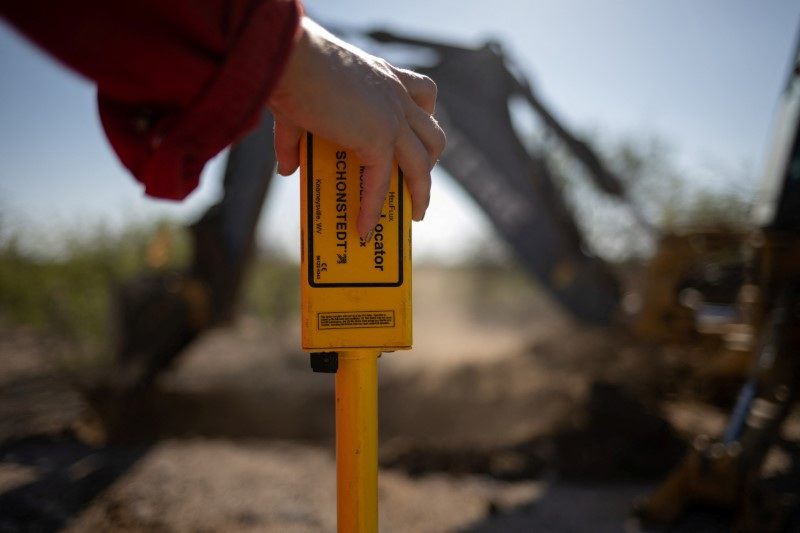Commodities
Texas oil regulator under scrutiny as zombie wells gush back to life

By Valerie Volcovici
PECOS COUNTY, Texas (Reuters) -On a sprawling ranch in Pecos County in late July, oil well control specialist Hawk Dunlap used a backhoe to uncover an abandoned or so-called zombie well that had sprung back to life despite being plugged just over a year earlier, hissing gas and bubbling toxic water into the dry Texas dirt.
Dressed in bright red coveralls and a silver hard hat, Dunlap hopped off the machine and into the hole to clear away remaining soil with a shovel, and then picked up a brittle chunk of cement that was part of the casing meant to keep fluids and gases underground. He crushed the cement into dust with a light squeeze of his fingers as the Briggs family, who own the ranch, formed a circle around him.
“This was not plugged properly,” Dunlap said. “This is the work of the three stooges of the Railroad Commission.”
The Railroad Commission (RRC) is the regulatory body that, despite its name, oversees oil and gas operations in Texas. And Dunlap, a three-decade veteran of oil fields around the globe, has become one of its most vocal critics.
Armed with a portable gas detector and mobile phone, Dunlap has spent much of the last two-and-a-half years documenting a flurry of oil well blow-outs and leaks across West Texas at the behest of landowners, in an epidemic he says is being caused by low-quality plugging jobs left behind by operators and their contractors and approved by the RRC.
He and his partner Sarah Stogner, an oil and gas lawyer who documents their work on social media, say they have now recorded over 100 leaking legacy or “orphan” wells with no responsible owner, which were listed in RRC records as properly plugged, including the one at the Briggs Ranch in Pecos County.
Reuters reporting in West Texas, along with interviews with landowners and experts and a review of RRC records show why the state regulator is under increased pressure to step up its oversight. The added scrutiny comes at a time when over the last two years, more and more abandoned wells have started to spill or even gushed geyser-like, formed salt and chemical-laden lakes or caused sinkholes.
Making matters worse is the rising pressure pushing up from beneath the ground due to the billions of gallons of wastewater injected back into reservoirs for disposal in latest fracking-led drilling boom in the Permian basin, the largest U.S. oilfield. That pressure, Dunlap says, likely causes the badly plugged wells to burst.
The U.S. Environmental Protection Agency said it would investigate whether to revoke the RRC’s permitting authority for waste disposal wells after Texas watchdog group Commission Shift filed a federal complaint alleging mismanagement.
RRC spokesperson Patty Ramon said the EPA has not yet contacted them to launch the review, and noted the agency previously commended its underground injection program.
“We will assist them with any input if they do,” Ramon said.
Faced with the rising number of calls from worried landowners, Dunlap is running a long-shot campaign to win one of the three RRC seats as a libertarian this autumn, hoping to change the organization from within.
“It’s about seeing that things are done right and not letting oil companies run over the citizens of Texas just because they produce oil and gas and pay some royalties,” he told Reuters.
Among the changes he would like to see: quicker and better quality plugging of wells, accountability for the oil companies who left them behind, and a new name for the Railroad Commission to make clear it regulates the oil industry.
“I spent 27 years roaming the Earth lauding the fact that Texas does it bigger and better than everybody else. So you have to understand that when we started excavating and investigating … it was, quite a bit of a gut punch for me,” said Dunlap, who has worked in 103 countries.
PERFECT STORM
Without a solvent owner of record, the responsibility of plugging these orphan wells falls on the RRC, which plans to plug 2,000 wells this year with state funds.
While the RRC has documented over 8,500 inactive or unplugged orphan wells in Texas, experts estimate there are thousands more undocumented, the legacy of more than a century of drilling, that are not eligible for closure funding.
Meanwhile, oil drillers working new wells in the Permian overlying Texas and New Mexico are accumulating around 24 million barrels daily of “produced water” – the salty mixture that comes up alongside oil and gas, according to Laura Capper with energy advisory EnergyMakers. Between 40-55% of this water is injected in local disposal wells, with much of the rest reused for oil operations, she said.
On top of concerns of produced water – laden with chemicals like radium and boron – threatening local aquifers and vegetation, all the drilling, pumping, and reinjection is causing the earth to rise and subside in places and triggering quakes, landowners and activists say.
“It is this perfect storm in the Permian with all this produced water, earthquakes and orphan wells,” said Adam Peltz, director of the Environmental Defense Fund’s Energy Program.
Deep injections of wastewater have triggered earthquakes, which has led to the RRC restricting new drilling permits in some areas. Shallower injections, however, overpressure the subsurface, causing poorly plugged wells to leak or blow.
The RRC pushed back on the assertion that the problem is widespread.
“There is little evidence of a widespread occurrence of previously plugged wells leaking,” Ramon said, adding that commission inspectors put “high-risk, high-priority wells” at the top of their plugging list.
In 2022, Texas received a $25 million initial grant from the bipartisan infrastructure law’s Orphaned Well Program to address the issue. It got another $80 million in January but with strings attached: use of the money requires the RRC to measure the amount of methane and other gases leaking from plugged wells before and after plugging.
The RRC has estimated that it will need over $481 million total to plug its wells.
Ramon said the RRC has used up the first tranche of federal funds and begun to tap into the larger tranche, in addition to its state orphan well funds. She said the agency is “complying with federal requirements.”
‘ONLY GETTING WORSE’
Meanwhile, scientists have been firming up the link between wastewater injection and erupting wells.
A paper published in July by Geophysical Research Letters by researchers from Southern Methodist University, for example, showed that a massive orphan well blowout in Crane County, Texas, in 2022 was caused mainly by wastewater injection taking place several miles away.
The RRC is also investigating the link but has not yet published a conclusion. It shut in two saltwater disposal wells after a series of earthquakes just northwest of Pecos County in the last week of July.
Back in Pecos County on the 800-acre (320-hectare) Briggs ranch that has 30 abandoned wells last productive in the 1980s, Laura Briggs said things have only been getting worse.
Less than one week after Dunlap dug up the previously plugged well on the property, a separate old leaking well less than 1,000 feet (300 m) from her house and animal pens suddenly had an explosive blowout of produced water. Briggs’ gas monitor showed high levels of toxic hydrogen sulfide.
“It’s been leaking for a year. I’ve reported it to the commission multiple times,” she said. “But it has to leak like this before the Railroad Commission will respond.”

In early August, a vacuum truck arrived at the ranch to start hauling away the fluid streaming out of the well as it pooled up near her livestock.
“It’s going to suck up what’s coming out of that well,” she said about the truck. “Then he’s going to take it off and dump it into a saltwater disposal well, which is why these wells are leaking.”
Commodities
Oil prices rise; U.S. crude inventories plunge, Russia-Ukraine truce eyed
Commodities
India’s Reliance to stop buying Venezuelan oil over US tariffs, sources say
Commodities
Oil prices climb on Venezuela supply worries

 Forex3 years ago
Forex3 years agoForex Today: the dollar is gaining strength amid gloomy sentiment at the start of the Fed’s week

 Forex3 years ago
Forex3 years agoUnbiased review of Pocket Option broker

 Forex3 years ago
Forex3 years agoDollar to pound sterling exchange rate today: Pound plummeted to its lowest since 1985

 Forex3 years ago
Forex3 years agoHow is the Australian dollar doing today?

 Cryptocurrency3 years ago
Cryptocurrency3 years agoWhat happened in the crypto market – current events today

 World3 years ago
World3 years agoWhy are modern video games an art form?

 Commodities3 years ago
Commodities3 years agoCopper continues to fall in price on expectations of lower demand in China

 Economy3 years ago
Economy3 years agoCrude oil tankers double in price due to EU anti-Russian sanctions

























